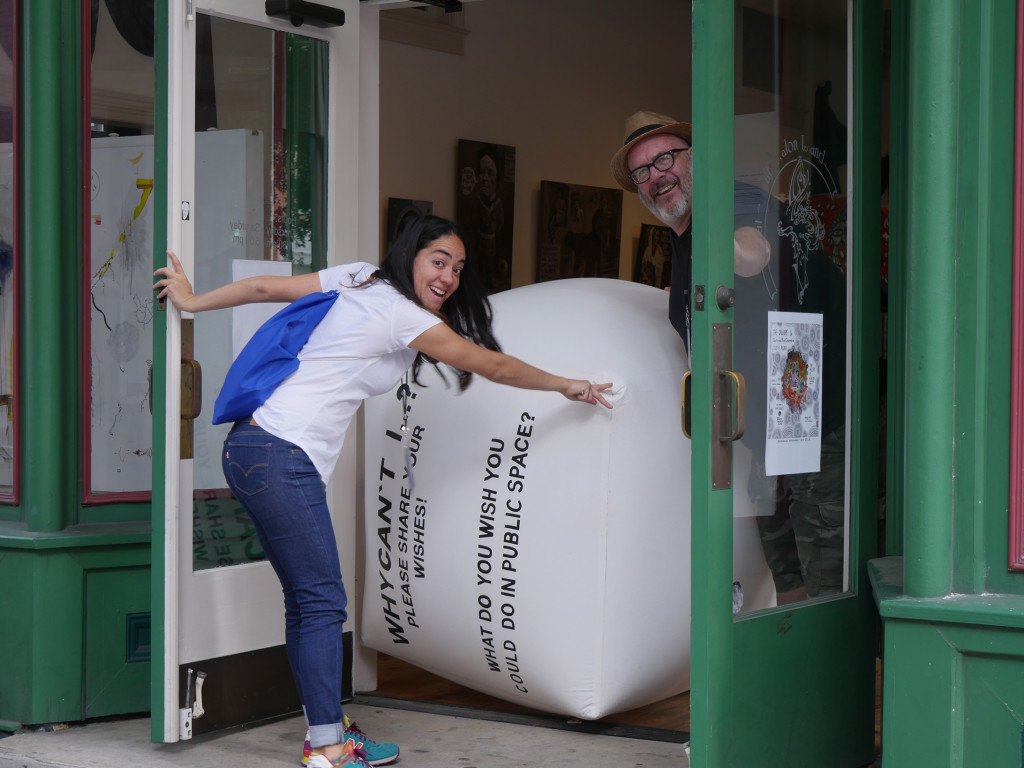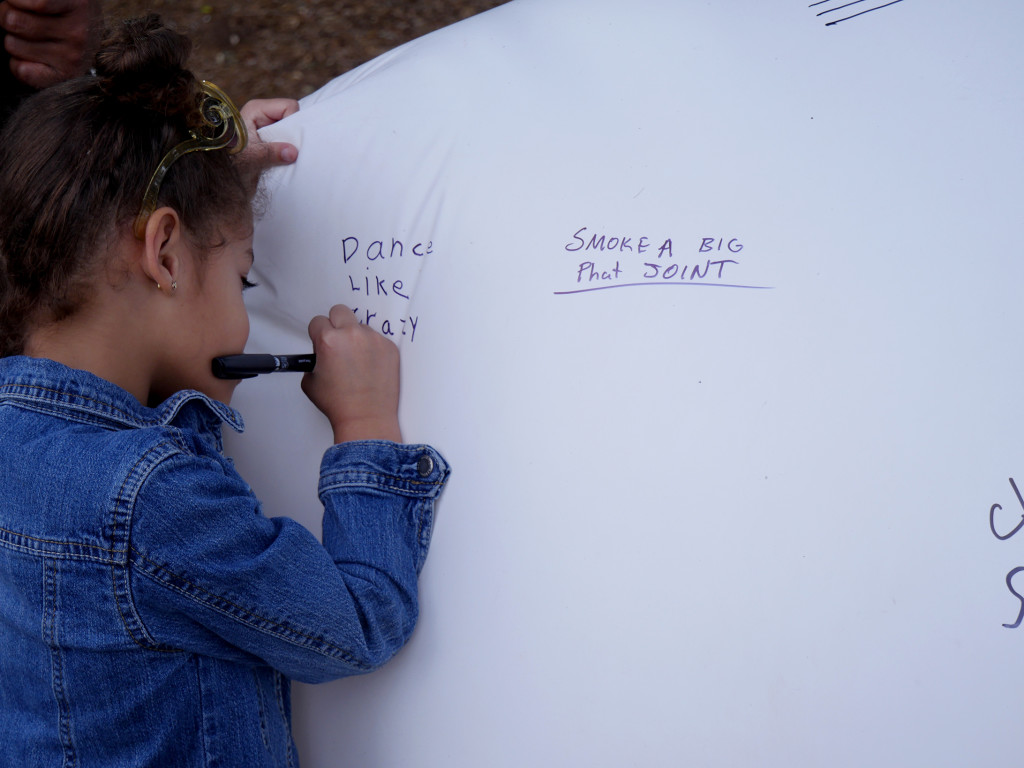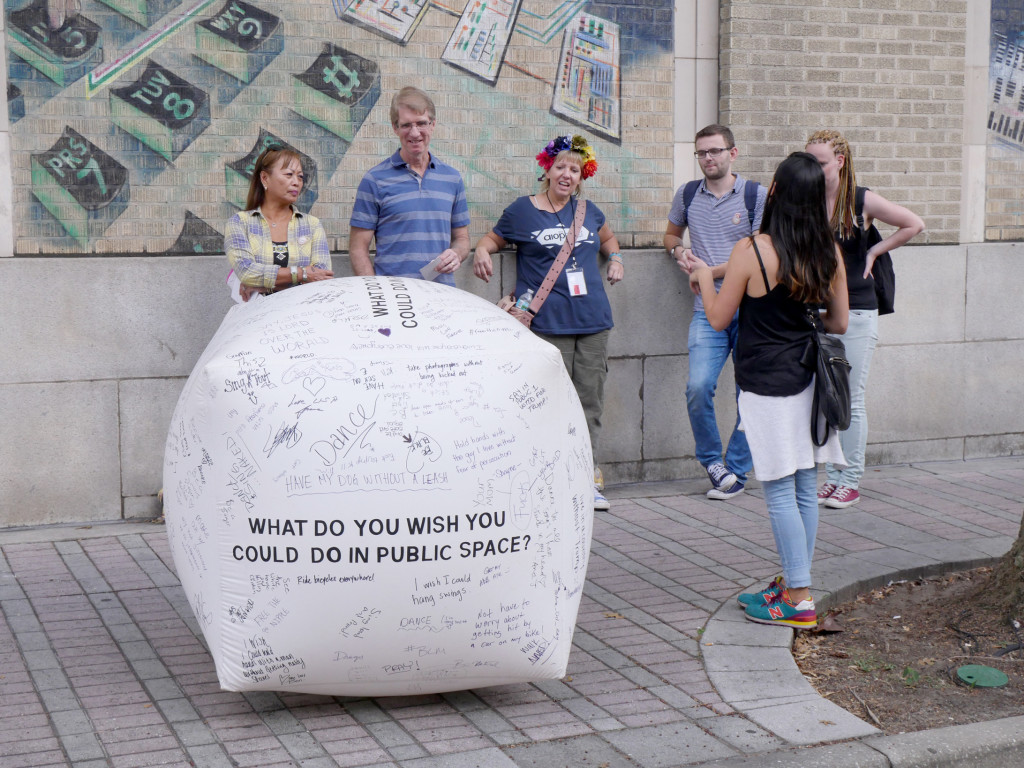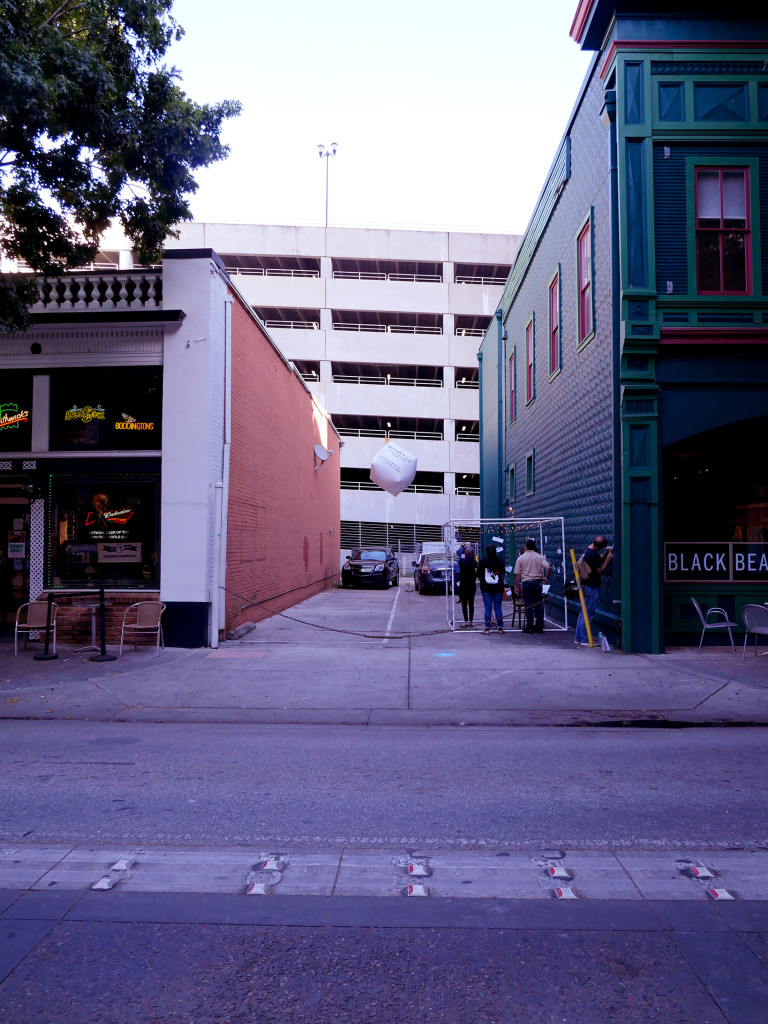
Art In Odd Places (AiOP) is really a space and time for odd things to happen. The day after the presidential election of 2016 (as the surprised Mexican I was at that point) I traveled to Orlando, FL., a state won by Donald Trump just 24 hours before our arrival. I remember sitting in front of the TV the night before thinking “this is actually happening.” As the piece I was presenting in AiOP required a little help, my boyfriend Gabriel came along.
The original project consisted in two workshops in which people could build recycled plastic swings and hang them to the trees around Eola Park area. The swings were perfect for the festival`s theme: PLAY, and since I´ve been hanging these for the last 7 years, it was a great opportunity to do it outside Mexico.
It turned out that the city of Orlando did not allow the hanging of these swings due to the risk of trees breaking and the safety of the people swinging. While it is difficult for a city government to allow people to attach things to urban structures, it is not at all unusual. The original idea had to be changed; I wanted to do something as a reply to this prohibition, so the new project had to accomplish three things:
- It had to be extremely flexible, ephemeral, mobile and, most important, free of being attached to anything in the city.
- It had to expose thoughts (mine and others) of un-doable things in public space in Orlando.
- It had to build a local reflection of the things people are most eager to do (perform) in a public space.
This ephemeral element would act as a parasite visitor, gathering information in a subtle and quick way without attaching to the city. It became clear that the project would consist in an inflatable shape that could be moved around easily and that, on it, one could read: Why Can`t I…? Followed by the question I had been trying to answer for the last five weeks: What do you wish you could do in public space?
Before traveling to Orlando, I started doing some research on the city`s legislation regarding public spaces. I was surprised to find out about the story of people from a religious group who got arrested for giving food to the homeless. My second surprise was learning about the Exempt Zones in Orland: blue boxes painted on the floor so street performers can “do their thing” inside these boxes.
“These boxes were painted in an effort to control panhandling. Citizens complained about aggressive panhandling, so an ordinance was drafted making it illegal to panhandle downtown. The blue boxes were created to protect first amendment rights, of freedom of speech.”(http://www.urbansketchers.org/2016/01/the-start-of-orlando-florida-blue-box.html)
Between all these situations, Oh Why Can`t I…? is an action with an object that belongs to no place. At the same time, it is a “wish wall” that publicly shows the desires of what people of a particular place want to do.

On opening day, we went out with the cube shaped balloon and rambled the streets downtown. Our expectations were not very high; the previous days I noticed that this is not a particularly crowded city. As an object that has a huge mobility and that easily goes far away with a little push, quickly we were outside the area designated for AiOP. We arrived to Lake Eola Park; the project had started, little crowds gathered in different moments as we rolled through the streets. It was a sight a bit striking to ignore, so people came just to ask what it was and ended up writing on it and chatting a bit with us.

By night the “balloon” was full of small phrases and drawings. Without a doubt, most of the writings expressed wishes to be naked, dance, shout and smoke marihuana. It kept going like that for the whole festival. The next days we tried to stick to the festival perimeter, but it was impossible. I was excited and it was impossible not to bring the balloon to the Pride Parade, anti-Trump protests, and Veterans Day Parade. Suddenly we were in a city were EVERYTHING was happening. We deflated the balloon and went straight to the closing AiOP party. After the party, we went dancing at Stardust, a nightclub in downtown Orlando. It was our last night so we were both tired and thrilled.

After a few hours and not few drinks, I started looking for my handbag as we decided to leave. I couldn`t find it anywhere and was desperate, as all our belongings were there: my wallet, ID’s, credit cards, drivers license, my cell phone (I had recently committed the stupidest thing and bought an expensive phone), and my boyfriend`s brand new camera with all the pictures from Oh Why Can`t I? Inside the bag were also both our passports and all the money from the stipend. Many people tried helping us, and there was even one girl who spent hours trying to calm me down. We retuned to the hotel and I cried myself to sleep.

The next morning I woke up crying; we started to look for the Mexican Consulate, which obviously was closed, as it was Sunday. We were about to change our flights when a phone began to ring. I saw a white cell phone, which I assumed was the property of the girl who helped me the night before and gave it to me to look for mine. I answer the phone and a girl on the other side tells me about how she had lost her phone, purse and her jacket, and could not tell me how I ended up with her phone. I told her I lost my purse as well, and I supposed at some point in the night she had given me her phone to look for mine. We were not able to sort out that part. Finally she added, “but I do have someone else`s purse, it is somebody called Maria…”

I jumped out of bed in excitement! “It`s mine! (My first name is Maria)” I said. We agreed to do the exchange at her hotel, which was 45 minutes away from ours. When we got there, we tried to recreate what had happened the night before. Apparently she saw me looking for my bag but did not pay much attention, when she left the club she took my bag by mistake, as both purses where black. I have had many nights of partying; I know things tend to get lost along with the memories of the night before. She told me that the only thing she remembered was arriving at her hotel in a cab and not being allowed in, since a drunk, sleepy woman without any identifications does not have much of a chance to get into a hotel room.

She spent about an hour convincing the people from the hotel that she really was who she said she was. They let her in, but she had to open her computer and show them identifications, emails, etc. When they left she fell asleep and forgot about the whole thing until the next morning when she found out that she had taken the wrong purse, and the only thing she had with her was her work phone. We exchanged our things, laughed for a while and said good-bye. Before I left, I quickly checked the things inside the bag. My phone was missing; we looked for it around the room but it wasn`t there. I felt a bit sad but thought it a minimal loss. We left the hotel and had a late breakfast at what every online tourist forum recommended as the best place to have breakfast in Orlando.

We flew back to Mexico City; on the plane I was reviewing what I would write on the report to the lost and found police department, and I planned to call my new friend`s hotel in case somebody returned my phone. I was determined to get it back. That was on Sunday. On Monday, I was getting used to the idea of freeing myself from a cell phone and walking with my head high when the last piece of the puzzle revealed itself to me. I was cleaning my purse when a business card slipped out from the outside pocket. It was a taxi card with a phone number on it; a very strange thing as we rented a car during our time in Orlando and never had to call a cab. I dialed the number and a Porto Rican accent answer the phone. I tried to explain the story, but I was only confusing the man. He told me that he indeed took my friend to her hotel after driving to Sea World and near Disney World, as he wasn`t able to understand where she wanted to go. “She wanted to go to Las Palmeras but kept saying Los Palermo,” said the driver. When they finally arrived to her destination, she asked him to wait downstairs while she went up to her room to get money to pay to him. He asked her to give him something in case she didn`t come back and she gave him a (my) phone. The driver then, very wisely, put his card inside her (my) bag in case she in fact, didn`t come back and would be looking for her phone the next day.

I called my friend to tell her this and immediately she contacted the man to settle her debt and got the phone back. She sent it to Houston, where a cousin of mine lives and was coming to visit in a few days. In the end, both of us got all of our stuff, but to this day we couldn’t figure out why I had her phone. Her things were safely at Stardust and it`s probably best that the phone part of the story remains a mystery.
Coincidences and surprises
To work in public space always involves two elements that are very close to each other: chance and surprise. More than a space of casual encounters, public space (the street) is an ideal terrain in which infinite elements of surprise await in every step we take.
Surprises can become coincidences when we are open and sensitive enough to let “things happen” and, literally, let go. These surprises turn into coincidences, build our stories, teach us lessons, and structure our immediate futures and the way we narrate them.

The series of drifts made as part of Oh Why Cant` I ?, involve making decisions that are taken consciously and unconsciously but, aside from that fact, the combination of coincidences and surprises leads to a formal situation that builds statements. In that sense, the result of the piece is built both by the people who did participate and by the people who didn’t. In the same way, I found my lost bag and cell phone because this particular girl (and not another girl) took it by mistake. Furthermore, the cell phone that I ended up having was property of the girl who took my bag and not any other girl.

By suppressing the conscious decisions that were made in this sequence of events and, only considering the non-controllable factors such as coincidences and surprises, a series of linked events is constructed. The one event would not happen without the other; everything engages in a consequential chain and non-controllable elements lead to wonderful things. AiOP is a great opportunity to experiment in-situ, as a growing desire for being surprised awakens in visitors. They look for coincidences and are open to “things to happen”. Artistic work of these characteristics must be resilient, they must be open to being surprised, flexible to change and sensitive to opportunities.

Oh Why Can`t I…? Is an action that comes up from a simple question: What can I do or don`t do in a public space? That arose from the impossibility to develop a previous project, which originally was designed to cling to certain elements of the city. Oh Why Can`t I…? is an object that gathers people`s wishes on a certain matter and exposes them publicly without attaching or adhering to any physical element of the urban sphere. If you want to know about this piece please send me an email to: elenamupe@gmail.com.

